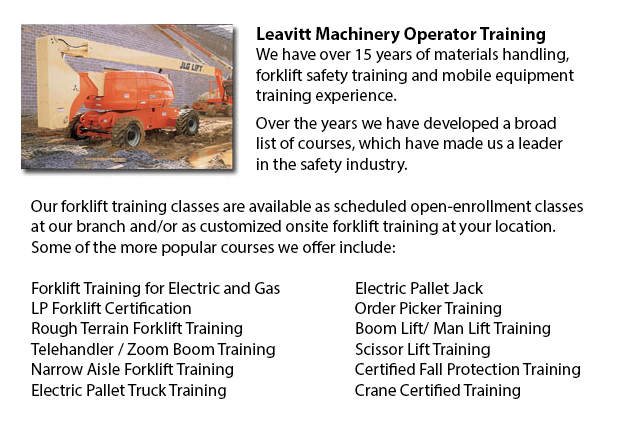
Manlift Training Vancouver - There are numerous manlift training programs which provide a review of the manlift machinery. The practicum portion of the training is one more important portion of the course. In this part the trainee has chance to demonstrate their practical abilities, their ability to safely operate a manlift. A requirement to Manlift training is the fall protection training, which could be included in the training based on the particular needs of the client.
Course Content
The program consists of the following areas of instruction: pre-shift equipment inspection and work area survey requirements; the impact of performing unsafe acts or operating unsafe equipment, Review of load capacities, Lifting devise equipment definitions, the specific machine requirements and safety decals, Review of related sections of the CSA Standards and the OHSA Standards and Review site specific Dangers, along with controls for safe utilization of a lifting device.
Demonstration and Evaluation Content
Demonstration and evaluation content consists of: Utilizing a spotter or a signaler when required; Proper personal protective equipment or likewise referred to as P.P.E. as needed; making use of the proper fitting harness or fall arrest devise; Using a lift only on level and solid ground; Utilizing the lift with all other workers clear of the job site; Aware of load limitations etc. and other specs as set out by the manufacturer; Having all associated equipment safely stored on the lift platform; Pre-shift work area survey and equipment inspection; Ensuring a safe and smooth operating speed for various plant conditions and isolating off the work place when major work projects are to be carried out.
Each individual would be tested to make certain they could efficiently and safely utilize your site-specific machinery.
Manlift Safety
Because the manlift is capable of lifting personnel and materials more than 20 feet in the air, these equipment pose a particular amount of risk and can be dangerous machines if not utilized properly. Because the danger is so apparent, lift operators and owners are careful to correctly maintain their machines and follow right operating procedures and safety measures. The ratio of accidents involving this particular apparatus is quite low.
The safe utilization of the manlift, boom lift and scissor lift is up to the operator of that equipment. They should understand all of the responsibilities that go with running the machine and how to utilize the lift vehicle safely. The most basic safety features on the machinery are safety decals and the operating manual. These show essential information about the operating procedures, safety equipment and maintenance.
Newer lift models will come together with instruction manuals and decals in place. Technically, the operating manual should be stored on the lift itself. If you are buying a second-hand lift, it is vital to ensure that the manual is included and that essential decals haven't been painted over. The restraints that prevent operators from falling and the guardrails are other essential safety features. These are standard and mandatory on all kinds of lifts.
-
Telehandler Ticket Vancouver
Telehandler Ticket Vancouver - The telescopic handler or telehandler is a frequently used equipment in agricultural and industrial applications. This equipment is similar in appearance to a forklift and also functions in a similar way, even if teleha... More -
Forklift Operator Certification Vancouver
Forklift Operator Certification Vancouver - Forklift operator certification is usually needed for employees working within industrial, warehouse or construction environments to guarantee the safe operation of forklifts. Workplace training need to fol... More -
Certified Fall Protection Training in Vancouver
There are high numbers of injuries at work linked to falling and a lot of fall-related deaths reported each and every year. The majority of these instances might have been avoided with better training, better measures in place, and by correctly equip... More -
Forklift Training Course Vancouver
Forklift Training Course Vancouver - CSA and OSHA establish criteria for forklift safety training which meets existing standards and regulations. Anyone planning to utilize a forklift is needed to successfully complete safety training prior to using... More -
Overhead Crane Certification Vancouver
Overhead Crane Certification Vancouver - The overhead crane certification course is a program that is designed to assist trainees, even if they have literacy or language restrictions. The course comprises a practical hands-on training session and a c... More -
Forklift Instructor Training Vancouver
Forklift Instructor Training Vancouver - Forklift Instructor training certification is recommended for forklift operators who would like to become instructors. To qualify for forklift instructor training, operators must be able to prove they possess... More -
Crane / Overhead Crane / Truck Mounted Crane / Hydraulic Cranes Training in Vancouver
Overhead cranes are likewise referred to as bridge cranes. They are actually a type of crane which comprises a hook and line apparatus which runs along a horizontal beam which runs along two widely separated rails. Lots of overhead cranes can be foun... More -
Scissor Lift Safety Training Vancouver
Scissor Lift Safety Training Vancouver - A scissor lift is a kind of platform lift that moves vertically. The lift table is moved in a vertical motion because of criss-cross folding supports which are linked in what is referred to as a pantograph. Th... More

Forklift Training Vancouver
TOLL FREE: 1-888-254-6157
24389 Fraser Highway
Langley, British Columbia
forklifttrainingvancouver.com
Email Us
About Us


